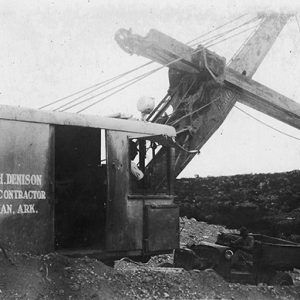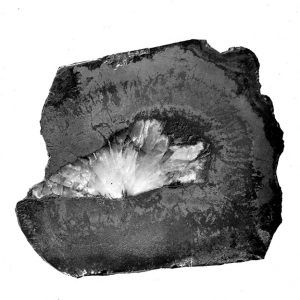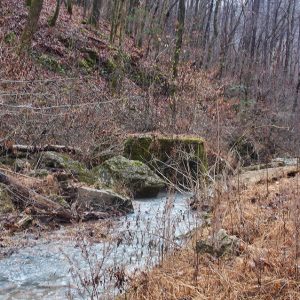calsfoundation@cals.org
Manganese Mining
The mining of manganese ore was a very important economic activity in Arkansas between 1849 and 1959. The region around Batesville (Independence County)—including about 100 square miles located in northwestern Independence County, southeastern Izard County, and northeastern Stone County—has produced more than ninety-eight percent of the manganese ore shipped from Arkansas. A second area including portions of Polk and Montgomery counties also contains manganese ores.
The first commercial exploitation of manganese was by Colonel Matthew Martin. Between 1848 and 1850, Martin purchased large tracts of land containing the ore, and, between 1850 and 1852, he shipped small quantities of manganese from Penter’s Bluff (Izard County) on the White River to Boston, New York, Philadelphia, and even Liverpool, England, where it was sent on to Glasgow, Scotland, to be used in the production of chlorine gas. Large-scale mining began at the end of the Civil War with large companies investing in the business. By 1867, steel companies were using manganese in the production of stronger and tougher steel. Manganese was in high demand. By 1881, the mines were producing large quantities of ore. The Keystone Mining Company, an Andrew Carnegie company, opened up a substantial operation in Independence County at Southern Hill in 1885. The St. Louis Mining Company quickly followed Keystone. However, shipping was a problem. The ore was taken by wagon or ox cart to White River for shipment, a fourteen-hour haul. The ore could also be hauled to Batesville for shipment by steamboat.
The St. Louis, Missouri, to Little Rock (Pulaski County) line of the St. Louis, Iron Mountain and Southern Railroad had been completed in 1872. Railroad officials saw the potential in the mining area and quickly began construction of a rail line from Newport (Jackson County) to the manganese mines. The line was completed to the area in 1886. A rail head was established in northern Independence County, where a depot and shipping facilities were built. The railroad called the terminus Cushman in honor of a railroad executive.
Because manganese is important in machinery production, demand for manganese ore was considerably higher during both world wars. During World War I, Italy, an American ally at the time, sent 900 soldiers to Cushman to mine manganese for the Italian war effort. Future U.S. president Herbert Hoover, then a young engineer, came to Cushman to survey the manganese fields for the U.S. government. Demand for the ore was also high during World War II, when overseas supplies were threatened by wartime activities in the shipping lanes. The highest single-year production of Arkansas manganese, however, was 1956, when more than 29,000 tons of the ore were extracted.
The more common manganese ores of Arkansas include Braunite, a steel-gray mineral that has a brownish-black streak and sub-metallic luster. Its manganese content ranges from sixty-three to sixty-six percent. Hausmannite is a brittle, steel-gray mineral with a chestnut-brown or reddish-brown streak. Wad, perhaps the most abundant, is a dark brown to black, very soft, earthy mineral that is commonly considered an impure hydrous oxide of manganese. It is very plentiful in the area and was in high demand during World War I. Most wad contains twenty to thirty percent manganese. Rhodochrosite is a pink carbonate of manganese. It is not abundant but is sometimes of gem quality. Gray carbonate is found deep in the fernvale limestone. Red or reddish-brown carbonate is also found. Batesville-area manganese ore tends also to contain phosphate, which is detrimental in steel production. Therefore, ore from the Montgomery–Polk County region was added to the Batesville ore to reduce the net phosphate content.
The manganese industry supported thousands of people in the area for many years. The area was boom or bust according to the demands for manganese. Finally, however, competition from foreign supplies was too much for the domestic business. A government program to stockpile manganese led to subsidies of the mining beginning in 1952, but the program ended in 1959 when the desired amount had been stockpiled. The last load of manganese ore produced in the district was shipped in August 1959, and then all manganese production ceased.
About 200 million tons of manganese deposits remain in the area, but foreign producers can supply it at a much lower price. The town of Cushman, now a quiet bedroom community, has celebrated a Miners Day festival every June since 1991.
For additional information:
Harder, E. C. Manganese Deposits of the United States, with Sections on Foreign Deposits, Chemistry and Uses. U.S. Geological Survey Bulletin 427. Washington DC: U.S. Geological Survey, 1910.
“Manganese.” Arkansas Geological Survey. Online at http://www.state.ar.us/agc/manganes.htm (accessed September 7, 2022).
Manganese Resources of the Batesville District, Arkansas. Information Circular 27. Little Rock: Arkansas Geological Commission: 1981.
Miser, Hugh D. Deposits of Manganese Ore in the Batesville District, Arkansas. U.S. Geological Survey Bulletin 734. Washington DC: U.S. Geological Survey, 1922.
———. Manganese Carbonate in the Batesville District, Arkansas. U.S. Geological Survey Bulletin 921-A. Washington DC: U.S. Geological Survey, 1940.
Stroud, Raymond B., et al. Mineral Resources and Industries of Arkansas. U.S. Bureau of Mines Bulletin 645. Washington DC: U.S. Bureau of Mines, 1969.
Smith, Jim, and Becky Wood. Cushman, Arkansas: The Boom Town That Wouldn’t Die. N.p.: 1994.
———. The Cushman Manganese Mines and the Batesville Manganese District Arkansas. N.p.: 1995.
James Smith
Batesville, Arkansas
Staff of the CALS Encyclopedia of Arkansas
 Business, Commerce, and Industry
Business, Commerce, and Industry W. H. Denison; Contractor
W. H. Denison; Contractor  Manganese Miners
Manganese Miners  Manganese Ore
Manganese Ore  Manganese Ore Washer
Manganese Ore Washer  Stark Spring Washer Remains
Stark Spring Washer Remains 



Comments
No comments on this entry yet.